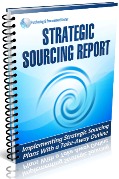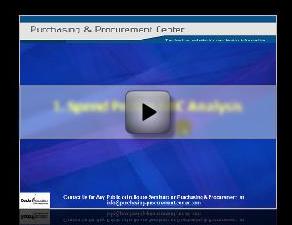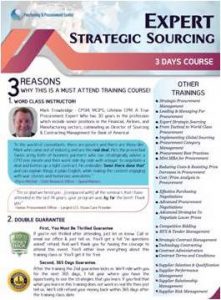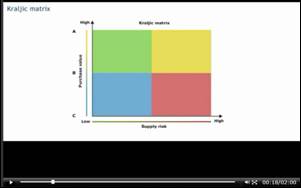10 Steps to Build a Successful Procurement Strategy

A strong procurement strategy is key to managing costs, improving efficiency, and building good supplier relationships.
By following a clear plan, businesses can reduce risks, ensure timely deliveries, and streamline operations.
These 10 steps will help you develop a successful procurement strategy that supports your company’s goals.
Check Out: Practical & Real-Life Procurement Training Courses
Why a Procurement Strategy Is Crucial for Business Success
Procurement is no longer just about purchasing goods and services—it has become a strategic function that directly impacts an organization's success. A well-developed procurement strategy can optimize supply chain efficiency, reduce operational costs, and enhance supplier collaboration.
For top procurement executives, it’s critical to adopt a strategy that not only meets short-term needs but also aligns with long-term business goals.
A 2023 Deloitte survey showed that 72% of procurement leaders now view procurement as a key lever for achieving broader business objectives, up from 60% in 2020. This shift indicates that procurement has evolved beyond tactical purchases to become a strategic function that drives competitive advantage and sustainability.
Key Components of an Effective Procurement Strategy
To create a procurement strategy that supports business objectives, there are several essential components to consider:
1. Clear Procurement Goals
Setting clear, measurable goals is the foundation of a successful procurement strategy. These goals should directly support your company's overall objectives, whether it's reducing supply chain costs, improving delivery times, or achieving sustainability targets.
For example, your goal could be reducing supply chain costs by 15% or improving supplier delivery accuracy. The clearer the goal, the easier it is to build a strategy around it.
2. Supplier Relationship Management
A crucial element of procurement strategy is managing and strengthening supplier relationships. Strong partnerships with reliable suppliers can help ensure consistent quality, fair pricing, and timely delivery. These relationships also enable procurement teams to collaborate on addressing potential disruptions and drive innovation.
According to PwC's 2022 report, 80% of procurement leaders believe that supplier collaboration is essential for ensuring supply chain resilience, especially during uncertain times.
Read More: 7 Best Procurement Practices
3. Technology Integration
Incorporating advanced technology into your procurement strategy can significantly improve efficiency and reduce costs. Procurement software solutions allow businesses to automate repetitive tasks, manage supplier data, track spending, and gain real-time insights into procurement operations.
The Hackett Group report revealed that companies using procurement technology have reduced procurement costs by up to 30%, demonstrating the significant impact that automation and data-driven decision-making can have on procurement performance.
4. Risk Management
Risk management is a cornerstone of any procurement strategy. Unforeseen disruptions like supplier delays, market fluctuations, and geopolitical events can derail procurement processes. Developing a risk management plan that accounts for these potential issues can safeguard the supply chain and ensure business continuity.
5. Sustainability and Ethical Sourcing
With increasing focus on sustainability, integrating ethical sourcing practices into your procurement strategy has become more important than ever. Businesses are expected to source materials responsibly, reduce waste, and minimize their environmental footprint.
In fact, Forbes reports that 2/3% of consumers are willing to pay more for sustainable products, making ethical sourcing an attractive proposition for both businesses and consumers.
Read More: Top 3 Best Procurement Certifications
10 Steps to Build a Procurement Strategy
Creating a successful procurement strategy is essential for businesses looking to improve efficiency, reduce costs, and build strong supplier relationships.
Here are 10 simple steps to help you develop an effective procurement strategy.
Step 1: Evaluate Current Procurement Practices
Start by reviewing your existing procurement processes. Look at past data, supplier performance, and feedback from your team. Identify areas where things are working well and areas that need improvement. This helps set the foundation for your new strategy.
Read More: STRATEGIC SOURCING TRAINING
Step 2: Analyze Market Conditions
Next, understand the broader market environment. Look at trends, potential price changes, and external risks (like geopolitical factors). By understanding the market, you can adjust your strategy to avoid risks and take advantage of opportunities.
Step 3: Set Clear Procurement Goals
Based on your evaluation and market analysis, set specific goals for your procurement strategy. These could include reducing costs, improving delivery times, or sourcing sustainably. Having clear goals helps guide the entire procurement process.
Step 4: Choose the Right Suppliers
Selecting reliable suppliers is key. Choose those who offer good quality, fair pricing, and timely delivery. It’s also important to consider their sustainability practices and ethical standards. Building strong relationships with the right suppliers can boost your procurement success.
Step 5: Negotiate and Formalize Contracts
Once you’ve chosen your suppliers, negotiate clear and fair contracts. The terms should protect both parties and set clear expectations. Well-drafted contracts help avoid misunderstandings and ensure smooth relationships in the future.
You Might Also Like COST REDUCTION IN PURCHASING & PROCUREMENT!
Step 6: Monitor Performance
After setting up your strategy, keep track of performance. Regularly measure supplier performance, cost savings, and delivery accuracy. Monitoring helps you identify issues early and make improvements when necessary.
Step 7: Manage Supplier Performance
Develop a system to manage and assess supplier performance over time. Set clear performance metrics and provide regular feedback to suppliers. This helps maintain good relationships and ensures ongoing improvement.
Step 8: Collaborate Across Departments
Procurement doesn’t work in isolation. Foster cooperation between procurement, finance, operations, and other departments. This ensures that everyone is aligned and working towards the same goals.
Check Out: The 7 Core Purchasing Strategies!
Step 9: Invest in Training
A successful procurement strategy relies on skilled professionals. Regular training ensures your team is up-to-date on the latest trends and technologies, improving their ability to execute the strategy effectively.
Step 10: Review and Adapt the Strategy
Finally, regularly review and update your procurement strategy to stay relevant. Adapt to changing market conditions and business needs to align your strategy with overall business goals.
Following these 10 steps, you can build a procurement strategy supporting your business's long-term success.
Check out these practical and recognized certifications to level up your skills here.
Check Out Accredited Procurement Certifications
The Certified International Procurement Manager (CIPM) certification helps you learn better procurement strategies, manage suppliers, and handle risks.
Learn more regarding the CIPM certification here to improve your skills and earn the credentials to advance in your procurement career.
Frequently Asked Questions (FAQs)
Q. Why is procurement strategy important?
Q. Why is procurement strategy important?
A: A well-defined procurement strategy is essential because it helps businesses manage costs, improve efficiency, and ensure a reliable supply chain. It aligns procurement activities with business goals, driving long-term success.
Q. What are the first steps in creating a procurement strategy?
Q. What are the first steps in creating a procurement strategy?
A: The first step is to evaluate your current procurement processes to identify gaps and opportunities for improvement. After that, analyze market conditions and set clear, measurable goals that align with your business objectives.
Q. How does technology help in procurement?
Q. How does technology help in procurement?
A: Procurement technology streamlines processes, reduces manual work, and provides real-time data that can inform better decision-making. It helps optimize supplier management, track spending, and improve overall procurement efficiency.
Q. How can I integrate sustainability into my procurement strategy?
Q. How can I integrate sustainability into my procurement strategy?
A: To integrate sustainability, focus on sourcing eco-friendly products, working with suppliers committed to sustainability, and reducing waste in your procurement processes. Sustainable procurement not only benefits the environment but also boosts your company's reputation.
Written by Lindsay Chesar (Education Director), Edited by Artin Vaqari (CEO Purchasing & Procurement Center), Updated by Azmi Anees









